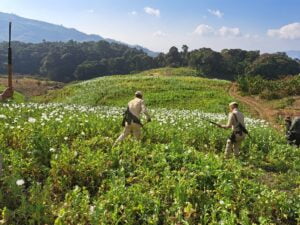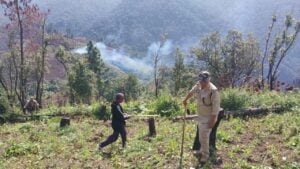One has no clue as to what type of herbicides/chemicals would be used to aerial spray on the poppy plants grown in the hills of Manipur. Once the chemical to be used is known and its merits and demerits in environmental terms are determined, it would be difficult to assess the overall impact on use of chemicals to exterminate illegal poppy plants in the state.
By Wakching Lai
Manipur chief minister N Biren Singh on Saturday (January 14, 2023) has successfully conducted demonstration and flight tests of drones on the lawn of his official residence. According to media reports, the drones, numbering four, were procured for aerial spraying of herbicides to destroy illicit opium poppy crops as part of the Manipur government’s War on Drugs campaign. Before the testing of the drones, the government of Manipur is reported to have received an aerial survey report submitted by a minister who led a select team of state officials on a helicopter inspection. It is said that the team detected mass poppy plantations in the interior hills of Churachandpur, Chandel, and Kangpokpi districts on January 13.
The government of Manipur seems literally serious on finally putting an end to the menace of illegal drugs trade by destroying poppy plantations. Earlier, the destruction of poppy plants were executed by deploying armed forces and anti-drugs & narcotics authorities who slashed the illegal plants grown on mountain slopes. Now, the state government is set to use drones to spray herbicides for in the hope that it would destroy illicit poppy plants as most of these plantations are grown in remote and inaccessible areas of the state.
Under the supervision of Hon’ble CM N.Biren Singh, the state government has procured drones which can spray herbicides and destroy poppy plantations. These drones also help in identifying those areas where poppy plantations are carried out. pic.twitter.com/CajnjEKZqg
— CMO Manipur (@manipur_cmo) January 14, 2023
Media reports inform us that the state government will soon conduct an aerial survey of forest areas using helicopters and drones and make an all-out effort to terminate any poppy plantation. The chief minister is reported to have directed the police and forest department not to spare anyone found guilty of destroying Manipur’s rich forest cover by cultivating poppy plants. The state government had also claimed that poppy plantation area has been “drastically reduced to 1,100 from 6,742 acres” from identified areas based on a survey. This truly implies that the government’s effort has seen a stupendous success in the last few years. This means, the government of Manipur now has a lesser effort to eradicate poppy cultivation.

Environmental impact of drug crop cultivation, destruction
While the hard efforts put in by the state government to finally destroy illegal poppy cultivation/plantation in Manipur so as to uproot the growing threat of drugs trade and consumption is all too palpable and can well be appreciated, it is also time to test not only the drones for aerial spraying of herbicides but also the very anti-drugs strategy/policy that the Manipur government is hell bent on adopting or rather implementing.
Here, it is noteworthy to acknowledge that the environmental impact of drug crop cultivation and destruction have been discussed in policy circles. The United Nations Office of Drug Control (UNODC) had also recognized that the herbicides and fertilizers used to grow and process coca or crops for making drugs are damaging to the environment. While we know that vast areas of forest are lost to poppy plantation in recent history of Manipur, there has been scant deliberation on the policy adopted by the state that could lead to dangerous environmental degradation. It is against this backdrop that we need to study the global scenario in a holistic way.
In a report titled The Impact of Drug Policy on the Environment published by Open Society Foundations in December 2015, Professor Kendra McSweeney of Ohio State University had called for a broad reconsideration of conventional “cat and mouse” policies that have driven growers, producers, and traffickers into new frontiers, causing deforestation and inviting chemical contamination into some of the most sensitive ecosystems on the planet, including national parks and indigenous reserves. McSweeney’s report was responding to calls by both the UN Commission on Narcotic Drugs and the Global Commission on Drug Policy for drug policy debates to be based on the latest and best empirical evidence. She had warned that “Among the many forms of collateral damage from drug policy that we already know about, we want the global community to know about the widespread harms to the environment.”
In a report titled The War on Drugs Isn’t Just Destroying Lives — It’s Also Killing the Environment, written for vice.com, Eva Hershaw said that “fumigation campaigns, for example, are commonly used as a means of drug crop eradication. They have been a cornerstone of the 15-year, multi-billion dollar Plan Colombia, an aid package created by the United States to fight drug trafficking in the South American country. For years, government planes sprayed glyphosate — the active ingredient in Monsanto’s Round Up — onto illicit coca crops, with notable impacts on wildlife, food crops, livestock, and the health of nearby residents”. In the case of Colombia, the plant that was to be destroyed was coca.
While one is clear about the fact that the use of herbicides to destroy or control poppy plants would also bring about environmental degradation, not many stakeholders are willing to discuss the pros and cons of the policy of aerial spraying herbicides on poppy plantations in Manipur. There are others who still believe that “contact killing” herbicides are best suited for the eradication campaign initiated by the authorities.
With a view to understand what is the idea and action of spraying chemicals to weed out poppy, we need to go a little deeper on what and how herbicidal treatments are sued for controlling or destroying poppy plants.
According to an article by M Horowitz for UNODC Bulletin on Narcotics (Horowitz M. Herbicidal treatments for control of Papaver somniferum L. Bull Narc. 1980;32(1):33-43. PMID: 6905769), fifty-five commercially available herbicides were evaluated for possible use to destroy illicit opium poppy crops (Papaver somniferum). He says that in the first stage, herbicides were sprayed on poppy plants grown in containers. This article says that the compounds that killed poppy plants are: “(a) herbicides with typical foliar activity–amitrole, bromoxynil, 2,4-D, glyphosate, ioxynil and paraquat; and (b) herbicides with root and foliar activity–the triazines ametryn, atrazine, metribuzin, prometryn, simazine and terbutryn; the substituted ureas benzthiazuron, chloroxuron, diuron, fluometuron, linuron, methabenzthiazuron, neburon and phenobenzuron; and the miscellaneous compounds karbutilate, methazole, oxadiazon and pyrazon. Severe but sublethal injury was caused by cycloate, EPTC, molinate, pobulate, cacodylate + MSMA, ethofumesate, perfluidone and phenmedipham”.
He observes that “small plants were severely injured by 2,4-D, killed rapidly by bromoxynil, ioxynil, paraquat (in mixture + diquat), and more slowly by glyphosate and metribuzin. The resistance to herbicides increased with the age of the poppy plant. Severe damage with partial kill of developed plants was obtained with bromoxynil, ioxynil, glyphosate, and paraquat + diquat; the last treatment produced the fastest effect”.
Another paper titled Coca and Poppy Eradication in Colombia: Environmental and Human Health Assessment of Aerially Applied Glyphosate by Solomon, K.R., Anadón, A., Carrasquilla, G., Cerdeira, A.L., Marshall, E.J.P., Sanin, LH. (2007) in Reviews of Environmental Contamination and Toxicology. Reviews of Environmental Contamination and Toxicology, vol 190. Springer, New York, evaluates the aerial spray programme to control coca and poppy production in Colombia with the herbicide glyphosate. “As a result of the use of best available spray and navigation technology, the likelihood of accidental off-target spraying is small and is estimated to be less than 1% of the total area sprayed. Estimated exposures in humans resulting from direct overspray, contact with treated foliage after reentry to fields, inhalation, diet, and drinking water were small and infrequent”. This paper goes on to add that analyses of surface waters in five watersheds showed that, on most occasions, glyphosate was not present at measurable concentrations; only two samples had residues just above the method detection limit of 25 microg/L. Concentrations of glyphosate in air were predicted to be very small because of negligible volatility. The formulation used in Colombia was a mixture of glyphosate and Cosmo-Flux and has low toxicity to mammals by all routes of exposure, although some temporary eye irritation may occur, said the paper.
Need for further study, deliberation
While the studies and report mentioned above may indicate some merits on the use of chemical sprays on poppy or coca, there have also been many studies conducted on the impact of using glyphosate or weed-killing herbicides/chemicals on plants and crops that human beings and animals consume. Here, one should note that we have no clue as to what type of herbicides/chemicals would be used to aerial spray on the poppy plants grown in the hills of Manipur. Once the chemical to be used is known and its merits and demerits in environmental terms are determined, it would be difficult to assess the overall impact on use of chemicals to exterminate illegal poppy plants in Manipur.

However, it should be noted that glyphosate, a non-selective systemic biocide with broad-spectrum activity that is widely used as a herbicide in the world persist in the environment for days or months. Experts have stated that its intensive and large-scale use can constitute a major environmental and health problem. We are aware that the effects of the herbicide/weed-killers on the nervous system of various animal species and humans. It has been scientifically assessed that exposure to glyphosate or its commercial formulations induces several neurotoxic effects. It is said that exposure to this pesticide during the early stages of life can seriously affect normal cell development by deregulating some of the signalling pathways involved in this process, leading to alterations in differentiation, neuronal growth, and myelination.
READ: https://www.ncbi.nlm.nih.gov/pmc/articles/PMC9101768/
Glyphosate present in herbicide exert significant toxic effect on neurotransmission and to induce oxidative stress, neuroinflammation and mitochondrial dysfunction, processes that lead to neuronal death due to autophagy, necrosis, or apoptosis, as well as the appearance of behavioral and motor disorders, says a paper titled Toxic Effects of Glyphosate on the Nervous System: A Systematic Review written by Carmen Costas-Ferreira, Rafael Durán, and Lilian R. F. Faro as published by National Center for Biotechnology Information, United States National Library of Medicine.
The paper further adds that the doses of glyphosate that produce these neurotoxic effects vary widely but are lower than the limits set by regulatory agencies. Although there are important discrepancies between the analyzed findings, it is unequivocal that exposure to glyphosate produces important alterations in the structure and function of the nervous system of humans, rodents, fish, and invertebrates, says the paper.

As one is not informed about the type of herbicide to be used for aerial spraying and destruction on poppy plants in Manipur, one cannot exactly tell whether at what concentration would a chemical like glyphosate would be used by the government of Manipur or whether or not the government would choose a totally different herbicide not harmful to the environment and the health of human beings. If the government of Manipur had actually deliberated on the use of aerial spraying of chemicals for the destruction on poppy plants in Manipur, it should have highlighted both the merits and demerits of the plan. Consulting stakeholders including environmental scientists would have been the correct approach, not that one is suggesting the government has bypassed the democratic process. What can we do at best is keep watching the government’s supposed drug policy roll over the sky with drones or without the drones.
